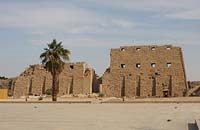Karnak Temple Complex
The temple complex of Karnak is the largest in Egypt and one of the largest in the world. It covers 247 acres and includes three precincts with some buildings outside the compounds. The modern name comes from the village of El-Karnak. The Egyptians called the complex Ipetisut which means “Most Select of Places.”
Karnak Location
Karnak is located in the city of Thebes and is over a mile from the city’s center and the temple of Luxor. Quays and processional ways link the three precincts to the Nile. The mortuary temples of the pharaohs and the Valleys of the Kings and Queens are on the Nile’s West bank across from Thebes. Karnak was a religious center for Egypt and was the seat of the cult of Amun/Amun-Ra.
Karnak History
The existing structures at Karnak date to the New Kingdom period. These buildings likely replaced older structures but no remains of them exist today. Successive rulers up to Roman times rebuilt, added to or restored Karnak’s buildings. Building at Karnak was a way to ensure immortality for the pharaoh and the favor of the gods.
Pharaohs commissioned carvings that detailed their building projects at Karnak. They also recorded their restoration work. These records indicated that the pharaohs believed restorations were as important as new buildings. A pharaoh would also complete unfinished projects started by his predecessor, especially his father.
A variety of scenes decorated the columns and walls of the temples. Some show rituals or festivals conducted in a specific area of the temple. Other inscriptions tell about the dedication of a building or an object. Records of a pharaoh’s military exploits decorated some buildings. The Egyptians painted these decorations but most of the color has worn away.
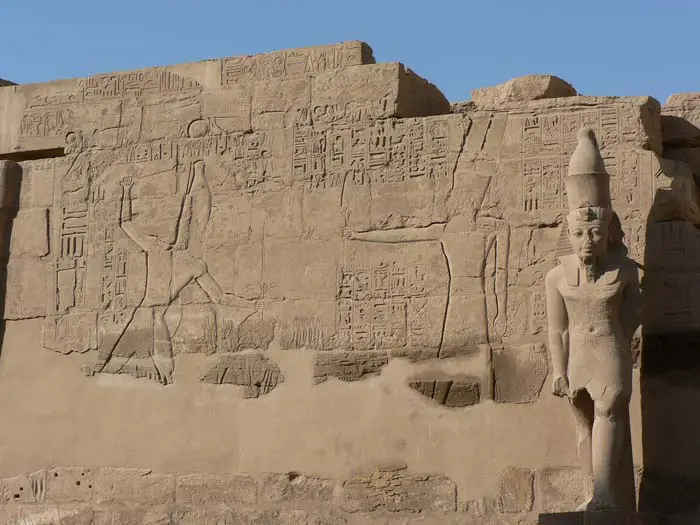
© eviljohnius - Wall Reliefs at Karnak
Deities at Karnak Temple
Egyptians worshiped many deities at Karnak but each precinct had a main temple. The three deities worshiped in these were Amun, Mut and Montu. Some of the other deities who had temples or chapels were Osiris, Ptah and Khonsu. The Theban Triad (Amun, Mut and Khonsu) traveled from Karnak to visit the mortuary temples on the West bank or to visit Luxor.
Karnak Temple Layout
The three temple complexes are in a North-South alignment. Amun’s precinct is the largest and in the center. Mut’s precinct is the South-most and the second largest. Montu’s precinct is the smallest and the highest North. The processional way that links Karnak and Luxor goes past the Western wall of Mut’s precinct.
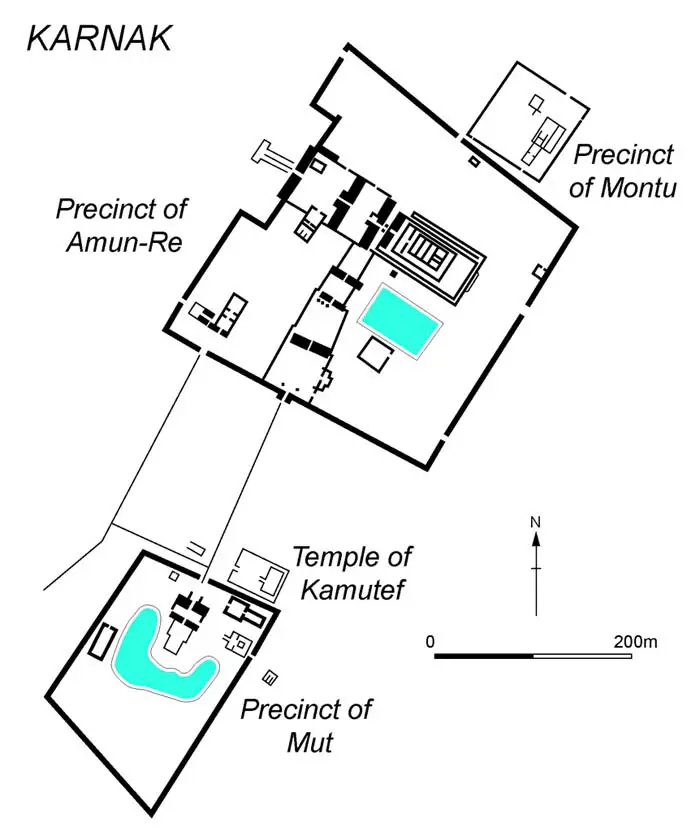
© Thomas Small - Layout of the Karnak Complex
Precinct of Amun
This complex contains the Great Temple of Amun and a variety of smaller temples. It is a massive precinct with a variety of buildings. It is difficult to see the true size of Amun’s temple in pictures.
The Amun Temple at Karnak
This temple has two axes; East-West toward the Nile and North-South toward Mut’s temple. The first pylon is at the Western entrance. Evidence shows that it was not completed. Criosphinxes line the processional way leading to the Nile. These statues had ram’s heads and were one of Amun’s emblems.
Several buildings are in the first courtyard. One of these is a triple barque station where the barques of Amun, Mut and Khonsu stopped during festivals. The remains of a giant kiosk also stands in this area but scholars are unsure of its use.
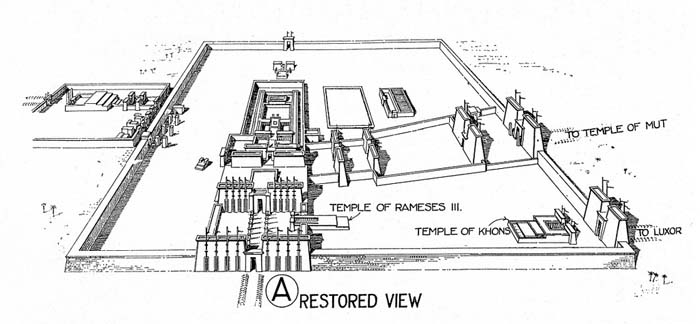
© psulibscollections - Reconstructed view of the Temple of Amun
A temple built by Ramesses III is on one side of the courtyard. This temple is a smaller version of the pharaoh’s mortuary temple. Statues of Ramesses III as Osiris line its small courtyard. This building was an elaborate barque shrine used when the Theban Triad traveled outside the temple.
The second pylon opens into the Great Hypostyle Hall. This large area has 134 columns topped by papyrus capitols. The twelve center columns are the largest. The area had a roof with small windows letting in some light. Each column is massive and several dozen people could stand on top of the largest ones.
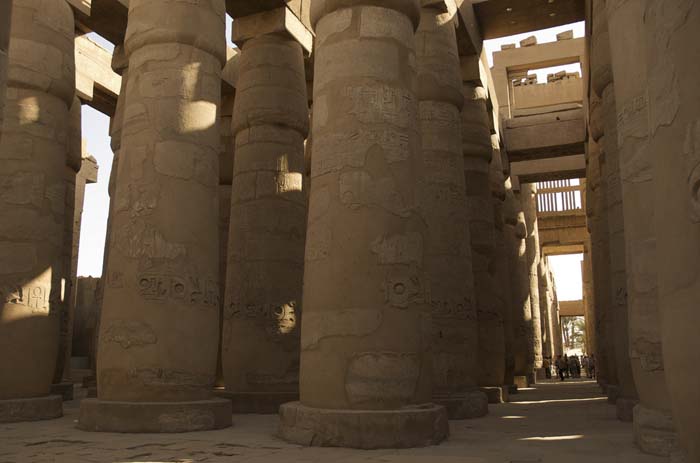
© Rick Manwaring - The Great Hypostyle Hall, Temple of Amun, Karnak
The third pylon leads to the court where the Southern axis begins. Four obelisks stood in this courtyard but only one remains.
The fourth and fifth pylons border the oldest remaining area of the temple. It is a court containing Egypt's largest obelisk, commissioned by Hatshepsut, and statues of Amun and Amunet, dedicated by Tutankhamun. Little remains of the inner sanctuary where the god’s statue resided.
The Southern axis begins with the seventh pylon. Scholars found a cache of 20,000 statues, statuettes and stelai in the courtyard beyond this pylon. Egyptologists are rebuilding pylons VIII to X, initially built by Hatshepsut (VIII) and Horemheb (IX and X).
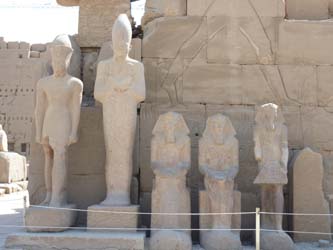
© Hannah Pethen - Statues by the Seventh Pylon
Rebuilt Buildings
Pharaohs deconstructed older structures and used them as wall fillers. Scholars have rebuilt several chapels in the courtyard between pylons one and two that they found inside walls. One is the white limestone chapel of Senwosret I. Another is a red quartzite chapel built by Hatshepsut.
Festival Temple of Thutmose III
Thutmose III built a festival temple behind the inner core of Amun’s temple. It has some unique features. Some of its columns look like tent poles. The poles likely represented the poles of a military tent. Thutmose III conducted several military campaigns.
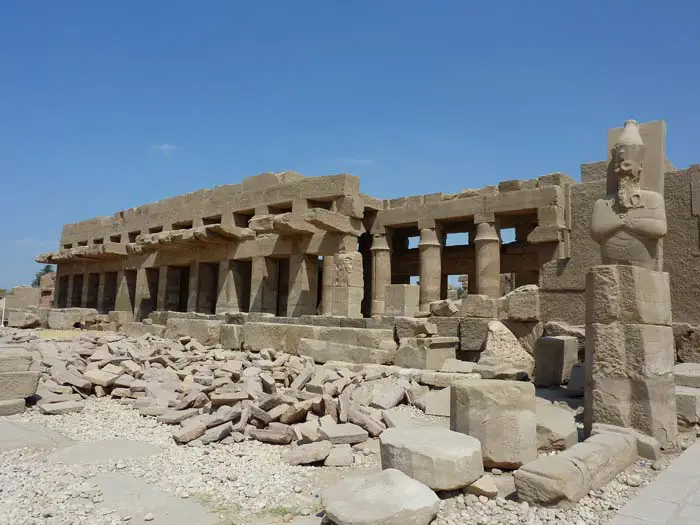
© Scott Sherrill-Mix - Festival Temple of Thutmose III
Khonsu Temple
A temple dedicated to Amun and Mut’s son, Khonsu is in the South-West corner of Amun’s precinct. It is a small temple that is relatively intact. A gate leads through the enclosure wall and links with Mut’s temple. There is a good view of Karnak from this building’s roof.
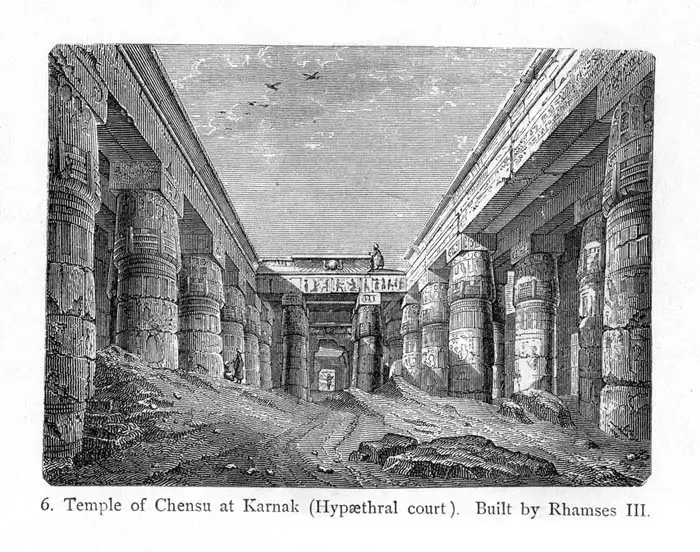
© psulibscollections - Khonsu Temple at Karnak
Opet Temple
Beside Khonsu’s temple is a small temple dedicated to the goddess Opet. This building served Amun in his form of Amun-Osiris. It has several crypts which the Egyptians used as tombs for the god. They also stored items used in a festival of resurrection in the crypts.
Sacred Lake
East of the Southern axis of Amun’s temple is the precinct’s sacred lake. It covers 100,000 square feet and scholars have filled it with water. The Egyptians used the lake for purification rituals and the priests’ daily ritual baths. Scholars found the remains of the priests’ houses near the sacred lake.
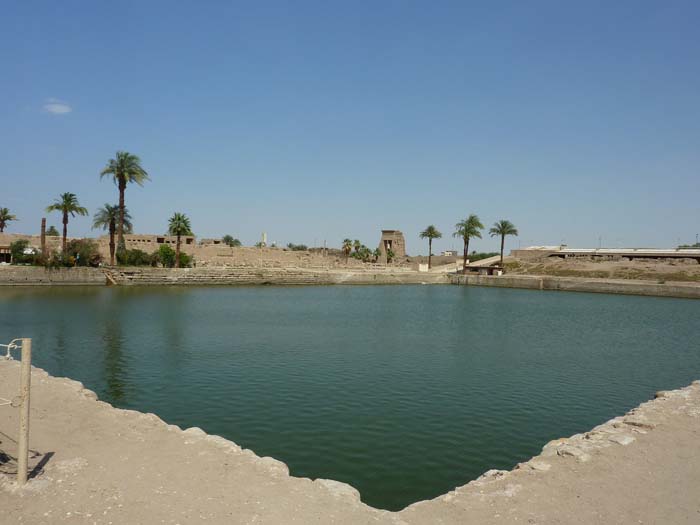
© Hannah Pethen - The Sacred Lake at Karnak
Ptah Temple
A temple dedicated to Ptah is near the Northern gate leading to Montu’s precinct. Ptah was a creator-god in Memphis. Three chapels were inside the temples core. Two were dedicated to Ptah and the third to the goddess Hathor. Today, a black granite statue of Sekhmet is in Hathor’s chapel.
Precinct of Mut
Temple of Mut
Mut’s temple is the largest in this complex. An entrance pylon leads to a narrow court. Another pylon opens into the inner core. This temple is famous for the black granite statues of Sekhmet that Amenhotep III placed there. Scholars believe he may have dedicated 700 of these statues. The precinct’s sacred lake encloses the temple on three sides.
Other Temples in Precinct
Several other buildings are in this precinct and two temples are well preserved. Ramesses III built one of them and decorated it with military scenes detailing his campaigns. Another temple was dedicated to the god Khonsupakherod (Khonsu the Child). This structure reused blocks from other buildings.
Structures between the Precincts of Amun and Mut
Two structures, that are now only foundations, lie between the Mut and Amun precincts. East of the connecting causeway is a temple dedicated to Amun Kamutef (Amun Bull of his Mother). West of the causeway is a barque shrine. Criosphinxes line the path between the precincts.
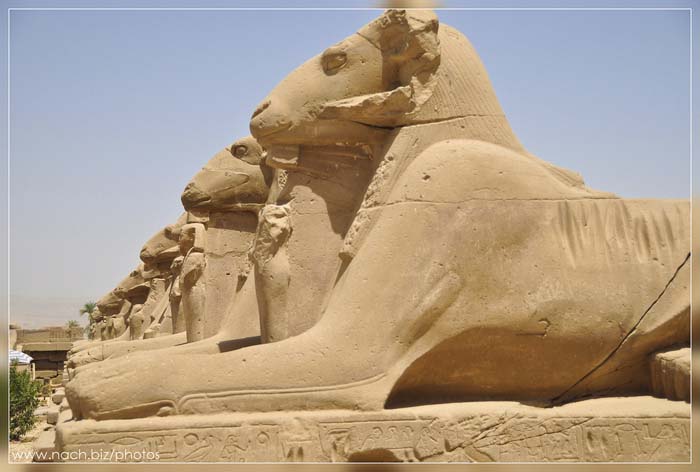
© -NACH- - Criosphinxes at Karnak
Precinct of Montu
Montu was the original falcon god of Themes. His temple is not well-preserved and has a North-South orientation. Parallel to Montu’s temple is one dedicated to the god Harpare, Montu’s son. A temple dedicated to Ma’at is at the Southern end of Montu’s temple.
Two buildings are outside the precinct. A temple built by Thutmose I is on the East. To the West, is a chapel dedicated to Osiris.
Temple of Akhenaten at Karnak
Akhenaten built a temple named Gem-pa-aten near Amun’s precinct during the first five years of his reign. After Akhenaten built Amarna, most of his building projects in Thebes stopped. Horemheb dismantled Gem-pa-aten and used it as filler to rebuild or expand Amun’s temple. Today, only Gem-pa-aten’s foundations remain in places.
Scholars are studying the temple’s remains to learn about its shape. This has been hard because modern homes cover most of the temple. Egyptologists think there was a large courtyard lined with a colonnade (a covered area held up by columns). They found statues of Akhenaten and Nefertiti in the court along with offering tables.
Part of the study of Gem-pa-aten includes the 36,000 blocks from the temple found inside the walls of Amun’s temple. Scholars have photographed them and tried to recreate the scenes on the walls. Images of rituals and the royal family have been pieced together. To date, more images of Nefertiti making offerings have been found than those of Akhenaten.
Karnak Facts
- Karnak is Egypt’s largest religious complex.
- Its Egyptian name was Ipetisut, “Most Select of Places.”
- Karnak consists of three precincts for Amun, Mut and Montu.
- Each precinct contains a main temple and smaller temples and chapels.
- Amun/Amun-Ra was the most important deity worshiped there.
- Pharaohs added to, restored or rebuilt Karnak.
- Karnak was one of Egypt’s religious centers.
- Scholars have found the foundations of and blocks from Akhenaten’s temple at Karnak and are studying the structure.

